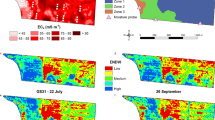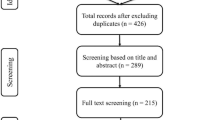Abstract
Crop water stress determination methods from canopy temperatures, derived from the surface energy balance equations, treat the canopy temperature under the assumption that the canopy behaves as a virtual “big-leaf”, covering the ground surface. Introduction of very high-resolution thermal imagery, 0.01–0.3-m pixel size, acquired from low altitude platforms, enabled finely detailed observation of the whole canopy, raising the question how to select the relevant canopy temperatures. One approach is to select the sunlit leaves confirming to the “big leaf” energy balance paradigm. However, thermal imagery alone is incomplete and needs additional marking or synchronized visible imagery for interpretation, which makes the process complicated and expensive. The other approach, used in reference surface based water stress evaluation, is to use full frame pixel statistics without pattern recognition by selecting the mean temperature of the cold fraction from the pixel histogram. That greatly simplifies processing for large-scale aerial thermography. Here are presented the results of experiments conducted in cotton and vine grapes, where both approaches were evaluated simultaneously. Ground referenced thermal and visible images were overlapped, and sunlit, shaded and whole canopy leaves were selected for crop temperature evaluation. The pixel histograms of the same images were analyzed in a two-step method, after discarding soil pixels where their temperature was 7 °C higher than air temperature at step one, and calculation of the mean temperatures of the lowest 33 and 100 % of the remaining pixels for step two. Several crop water stress indices were compared with leaf and stem water potentials and stomatal conductance. Good agreement was found between both image segmentation and histogram analysis methods, demonstrating the suitability of both methods in canopy temperature evaluation for crop water stress evaluation.




Similar content being viewed by others
References
Alchanatis, V., Cohen, Y., Cohen, S., Moller, M., Meron, M., et al. (2006). Fusion of IR and multispectral images in the visible range for empirical and model-based mapping of crop water status. ASAE Paper Number 061171.
Alchanatis, V., Cohen, Y., Cohen, S., Moller, M., Sprinstin, M., Meron, M., et al. (2009). Evaluation of different approaches for estimating and mapping crop water status in cotton with thermal imaging. Precision Agriculture, 11(2), 148–162.
Alves, I., Perrier, A., & Pereira, L. S. (1998). Aerodynamic and surface resistances of complete cover crops: How good is the “Big leaf”? ASAE, 41(2), 345–351.
Cohen, Y., Alchanatis, V., Meron, M., Saranga, Y., & Tsipris, J. (2005). Estimation of leaf water potential by thermal imagery and spatial analysis. Journal of Experimental Botany, 56, 1843–1852.
Fuchs, M. (1990). Infrared measurement of canopy temperature and detection of plant water stress. Theoretical and Applied Climatology, 42(4), 253–261.
Irmak, S., Haman, D. Z., & Bastug, R. (2000). Determination of crop water stress index for irrigation timing and yield estimation of corn. Agronomy Journal, 92, 1221–1227.
Jackson, R. D., Idso, S. B., Reginato, R. J., & Pinter, P. J. (1981). Canopy temperature as a crop water stress indicator. Water Resources Research, 17, 1133–1138.
Jiménez-Bello, M. A., Ballester, C., Castel, J. R., & Intrigliolo, D. S. (2011). Development and validation of an automatic thermal imaging process for assessing plant water status. Agricultural Water Management, 98, 1497–1504.
Leinonen, I., & Jones, H. G. (2004). Combining thermal and visible imagery for estimating canopy temperature and identifying plant stress. Journal of Experimental Botany, 55(401), 1423–1431.
Meron, M. (1987). Measurement of cotton leaf temperatures with imaging IR radiometer. In Proceedings of International Conference on Measurement of Soil and Plant Water Status (pp. 111–113). Utah State University, Logan, UT.
Meron, M., Grimes, D. W., Phene, C. J., & Davis, K. R. (1987). Pressure chamber procedures for leaf water potential measurements of cotton. Irrigation Science, 8, 215–222.
Meron, M., Tsipris, J., & Charitt, D. (2003). Remote mapping of crop water status to assess spatial variability of crop stress. In J. Stafford & A. Werner (Eds.), Proceedings of 4th European Conference on Precision Agriculture (pp. 405–410). Wageningen Academic Publishers, Berlin.
Moller, M., Alchanatis, V., Cohen, Y., Meron, M., Tsipris, J., et al. (2007). Use of thermal and visible imagery for estimating crop water status of irrigated grapevine. Journal of Experimental Botany, 58(4), 827–838.
Moran, M. S., Rahman, A. F., Washburne, J. C., Goodrich, D. C., Weltz, M. A., & Kustas, W. P. (1996). Combining the Penman–Monteith equation with measurements of surface temperature and reflectance to estimate evaporation rates of semiarid grassland. Agricultural and Forest Meteorology, 80, 87–109.
Naor, A. (1998). Relationships between leaf and stem water potentials and stomatal conductance in three field-grown woody species. Journal of Horticultural Science and Biotechnology, 73, 431–436.
Petersen, K. L., Fuchs, M., Moreshet, S., Cohen, Y., & Sinoquet, H. (1992). Computing transpiration of sunlit and shaded cotton foliage under variable water stress. Agronomy Journal, 84, 91–97.
Raupach, M. R., & Finnigan, J. J. (1988). Single-layer models of evaporation from plant canopies are incorrect but useful, whereas multilayer models are correct but useless: Discussion. Australian Journal of Plant Physiology, 15, 705–716.
Samson, R., & Lemeur, R. (2001). Energy balance storage terms and big-leaf evapotranspiration in a mixed deciduous forest. Annals of Forest Science, 58, 529–541.
Sela, E., Cohen, Y., Meron, M., Alchanatis, V., Cohen, S., et al. (2007). Use of thermal imaging for estimating and mapping crop water stress in cotton. In J. Stafford (Ed.), Proceedings of 6th European Conference on Precision Agriculture (pp. 365–371). Wageningen Academic Publishers, Skiathos.
Tanner, C. B., & Fuchs, M. (1968). Evaporation from unsaturated surfaces: a generalized combination method. Journal Geophysical Research, 73, 1299–1304.
Wang, X., Yang, W., Wheaton, A., Cooley, N., & Moran, B. (2010). Automated canopy temperature estimation via infrared thermography: A first step towards automated plant water stress monitoring. Computers and Electronics in Agriculture, 73, 74–83.
Weiß, M., & Menzel, L. (2008). A global comparison of four potential evapotranspiration equations and their relevance to stream flow modeling in semi-arid environments. Advanced Geoscience, 18, 15–23.
Zia, S., Spohrer, K., Merkt, N., Wenyong, D., He, X., & Müller, J. (2009). Non-invasive water status detection in grapevine (Vitis vinifera L.) by thermography. International Journal of Agriculture & Biological Engineering, 2(4), 46–54.
Author information
Authors and Affiliations
Corresponding author
Rights and permissions
About this article
Cite this article
Meron, M., Sprintsin, M., Tsipris, J. et al. Foliage temperature extraction from thermal imagery for crop water stress determination. Precision Agric 14, 467–477 (2013). https://doi.org/10.1007/s11119-013-9310-0
Published:
Issue Date:
DOI: https://doi.org/10.1007/s11119-013-9310-0




